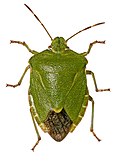Insect
Insects are a group of arthropods that are characterized by their three-part bodies, three pairs of jointed legs, compound eyes, and one pair of antennae. They are the most diverse group of animals on the planet, including more than a million described species and representing more than half of all known living organisms.
Classification[edit]
Insects are classified in the taxonomic class Insecta, and are further divided into 30 orders. These orders include Coleoptera (beetles), Diptera (flies), Lepidoptera (butterflies and moths), and Hymenoptera (ants, bees, and wasps), among others.
Anatomy[edit]
Insects have a highly differentiated body, divided into three main parts: the head, the thorax, and the abdomen. The head supports a pair of sensory antennae, a pair of compound eyes, and mouthparts. The thorax is specialized for locomotion, bearing three pairs of legs and usually one or two pairs of wings. The abdomen is adapted for digestion and reproduction.
Life Cycle[edit]
Insects typically undergo a process of metamorphosis, which is a series of physical transformations after birth. There are two types of metamorphosis: incomplete metamorphosis, where the insect grows by shedding its skin, and complete metamorphosis, where the insect goes through four distinct stages: egg, larva, pupa, and adult.
Role in Ecosystem[edit]
Insects play crucial roles in various ecosystems as pollinators, recyclers of nutrients, scavengers, and as a part of the food chain. They are also known to be vectors for diseases, and some species are significant pests for agriculture.
Human Interaction[edit]
Humans interact with insects in a variety of ways, not all of them beneficial. Insects can act as disease vectors, carrying pathogens that can infect humans. However, they also play a crucial role in pollination, which is vital for food production.
See Also[edit]
|
|
|
-
Insects - Neoptera - Paleoptera - Apterygota
-
Insect world of motion
-
Gemeine Heidelibelle (Sympetrum vulgatum)
-
Wolfsspinne Trochosa
-
Armadillidium vulgare
-
Scolopendra viridicornis nigra
-
Milli's on the back
-
Eukaryote species pie tree
-
Palomena prasina
-
Peacock butterfly (Aglais io)
-
Asilidae by kadavoor
-
Specimen of Podalonia tydei (Le Guillou, 1841)
Ad. Transform your life with W8MD's Budget GLP-1 injections from $75


W8MD offers a medical weight loss program to lose weight in Philadelphia. Our physician-supervised medical weight loss provides:
- Weight loss injections in NYC (generic and brand names):
- Zepbound / Mounjaro, Wegovy / Ozempic, Saxenda
- Most insurances accepted or discounted self-pay rates. We will obtain insurance prior authorizations if needed.
- Generic GLP1 weight loss injections from $75 for the starting dose.
- Also offer prescription weight loss medications including Phentermine, Qsymia, Diethylpropion, Contrave etc.
NYC weight loss doctor appointmentsNYC weight loss doctor appointments
Start your NYC weight loss journey today at our NYC medical weight loss and Philadelphia medical weight loss clinics.
- Call 718-946-5500 to lose weight in NYC or for medical weight loss in Philadelphia 215-676-2334.
- Tags:NYC medical weight loss, Philadelphia lose weight Zepbound NYC, Budget GLP1 weight loss injections, Wegovy Philadelphia, Wegovy NYC, Philadelphia medical weight loss, Brookly weight loss and Wegovy NYC
|
WikiMD's Wellness Encyclopedia |
| Let Food Be Thy Medicine Medicine Thy Food - Hippocrates |
Medical Disclaimer: WikiMD is not a substitute for professional medical advice. The information on WikiMD is provided as an information resource only, may be incorrect, outdated or misleading, and is not to be used or relied on for any diagnostic or treatment purposes. Please consult your health care provider before making any healthcare decisions or for guidance about a specific medical condition. WikiMD expressly disclaims responsibility, and shall have no liability, for any damages, loss, injury, or liability whatsoever suffered as a result of your reliance on the information contained in this site. By visiting this site you agree to the foregoing terms and conditions, which may from time to time be changed or supplemented by WikiMD. If you do not agree to the foregoing terms and conditions, you should not enter or use this site. See full disclaimer.
Credits:Most images are courtesy of Wikimedia commons, and templates, categories Wikipedia, licensed under CC BY SA or similar.
Translate this page: - East Asian
中文,
日本,
한국어,
South Asian
हिन्दी,
தமிழ்,
తెలుగు,
Urdu,
ಕನ್ನಡ,
Southeast Asian
Indonesian,
Vietnamese,
Thai,
မြန်မာဘာသာ,
বাংলা
European
español,
Deutsch,
français,
Greek,
português do Brasil,
polski,
română,
русский,
Nederlands,
norsk,
svenska,
suomi,
Italian
Middle Eastern & African
عربى,
Turkish,
Persian,
Hebrew,
Afrikaans,
isiZulu,
Kiswahili,
Other
Bulgarian,
Hungarian,
Czech,
Swedish,
മലയാളം,
मराठी,
ਪੰਜਾਬੀ,
ગુજરાતી,
Portuguese,
Ukrainian














